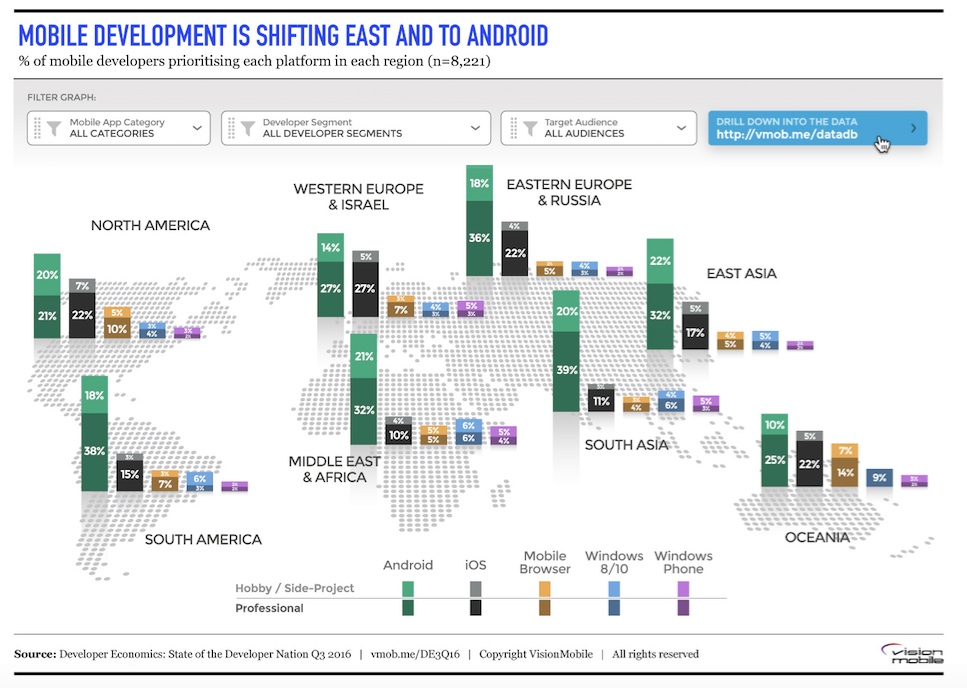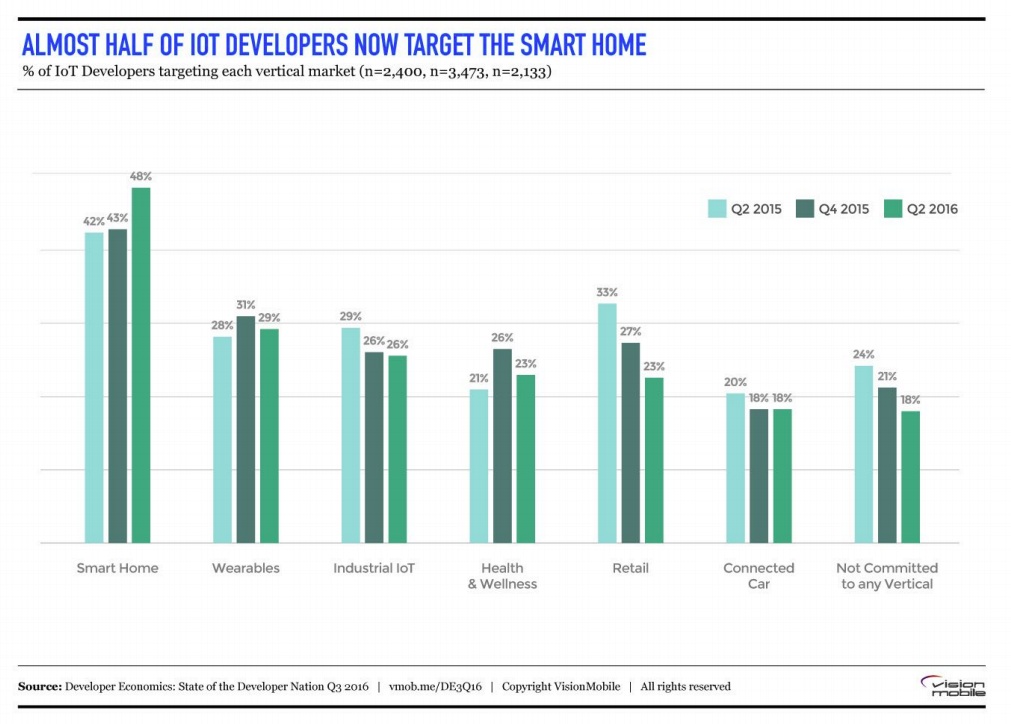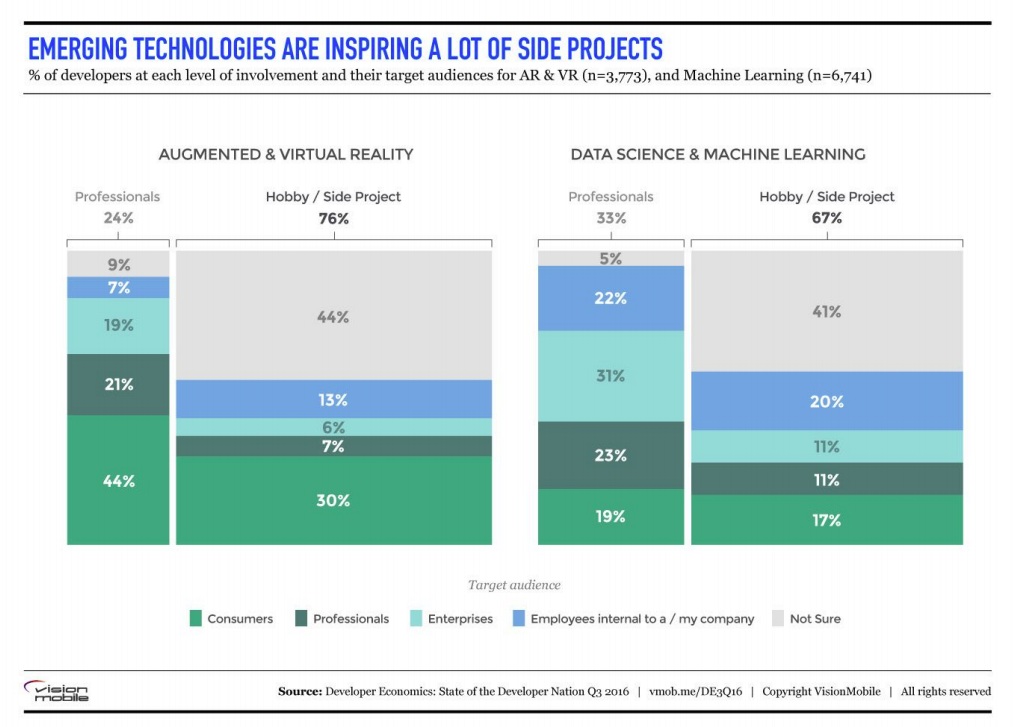Progress announced new powerful capabilities and enhancements in the latest release of Progress® Sitefinity®.
VisionMobile has just released its new State of The Developer Nation Report for Q3 2016 based on the world's largest survey of software developers. Here at Heavybit, a program that helps developer-focused startups take their product market, we look forward to VisionMobile’s reports that allow us to keep up-to-date on the shifts in the developer landscape.
This quarter’s report delves into the key developer trends for 2016 and discusses mobile platforms, desktop platforms, server side languages, IoT markets, and the adoption of emerging technologies. Here are a few highlights from the report:
Mobile Platform Wars
After years of stability, Android is now extending its dominance in device sales to even greater developer mindshare and priority over iOS.
In addition, Android is leaping to a new record for any platform since VisionMobile started measuring in 2010, with 79% mindshare amongst mobile developers. Interestingly, 47% of professional developers now consider Android their primary platform, up 7 percentage points in the last 6 months. Also notable, the number of professionals who consider iOS their primary platform fell 8 percentage points from 39% just six months ago to 31% in VisionMobile’s most recent survey.
When looking at geographic trends, there was a strong bias towards Android in the East and slight bias towards iOS in the West, with many more developers being based in the West.

Desktop and Cloud Developer Tribes
Developers can be quite a tribal bunch. They often band together around particular technology clusters, engaging in endless ideological or technical debates with those that choose other technologies about which is "best." A lot of developers, although far from all, can end up living within particular technology ecosystems, and learning new technologies from within those to solve new problems.
Microsoft is clearly having some success shepherding Windows classic developers towards newer technologies; an impressive 36% primarily use C# on the server. Developers that primarily target Linux or macOS on the desktop are extremely unlikely to use C# on the server. Just 2% of Linux-first developers and 3% of those that prefer macOS are primarily using C# for their backend.

A New Phase in the IoT Market
The wave of IoT newcomers is coming to an end. Throughout 2015 roughly half of the IoT developer population were newbies – 57% in our Q2 2015 survey, and 47% in Q4 2015 had less than an a year of experience, that proportion dropped to 22% in Q2 2016.
In regards to verticals, VisionMobile is starting to get a large pool of fairly experienced IoT developers who know what they’re after; a more mature, more focused, IoT community. And what’s the first vertical that many IoT developers pick? Smart Home. Almost half (48%) of the IoT developer population now targets the Smart Home. The next most popular vertical is Wearables, at 29% a distant second. Smart Home is not just the biggest vertical in terms of developer interest, but also the fastest growing – up from 42% a year earlier.

Where Are Developers Looking Next?
Where are developers looking next? Augmented and virtual reality, and machine learning – are they just the latest over-hyped technologies or the next big things? The level of developer interest in both areas suggests the latter. Nearly 23% of developers are already involved in either AR or VR development, most of those as a hobby or side project. An amazing 41% of developers are involved in data science or machine learning in some way, 33% of those in a professional capacity.

The survey reached an impressive 16,500+ respondents from 145 countries around the world. This Developer Economics series continues to be the most global independent research on mobile, desktop, IoT and cloud developers combined ever conducted.
Malia Powers is Communications Manager at Heavybit
Industry News
Red Hat announced the general availability of Red Hat Enterprise Linux 9.5, the latest version of the enterprise Linux platform.
Securiti announced a new solution - Security for AI Copilots in SaaS apps.
Spectro Cloud completed a $75 million Series C funding round led by Growth Equity at Goldman Sachs Alternatives with participation from existing Spectro Cloud investors.
The Cloud Native Computing Foundation® (CNCF®), which builds sustainable ecosystems for cloud native software, has announced significant momentum around cloud native training and certifications with the addition of three new project-centric certifications and a series of new Platform Engineering-specific certifications:
Red Hat announced the latest version of Red Hat OpenShift AI, its artificial intelligence (AI) and machine learning (ML) platform built on Red Hat OpenShift that enables enterprises to create and deliver AI-enabled applications at scale across the hybrid cloud.
Salesforce announced agentic lifecycle management tools to automate Agentforce testing, prototype agents in secure Sandbox environments, and transparently manage usage at scale.
OpenText™ unveiled Cloud Editions (CE) 24.4, presenting a suite of transformative advancements in Business Cloud, AI, and Technology to empower the future of AI-driven knowledge work.
Red Hat announced new capabilities and enhancements for Red Hat Developer Hub, Red Hat’s enterprise-grade developer portal based on the Backstage project.
Pegasystems announced the availability of new AI-driven legacy discovery capabilities in Pega GenAI Blueprint™ to accelerate the daunting task of modernizing legacy systems that hold organizations back.
Tricentis launched enhanced cloud capabilities for its flagship solution, Tricentis Tosca, bringing enterprise-ready end-to-end test automation to the cloud.
Rafay Systems announced new platform advancements that help enterprises and GPU cloud providers deliver developer-friendly consumption workflows for GPU infrastructure.
Apiiro introduced Code-to-Runtime, a new capability using Apiiro’s deep code analysis (DCA) technology to map software architecture and trace all types of software components including APIs, open source software (OSS), and containers to code owners while enriching it with business impact.
Zesty announced the launch of Kompass, its automated Kubernetes optimization platform.
MacStadium announced the launch of Orka Engine, the latest addition to its Orka product line.




